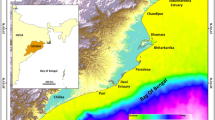Abstract
A Liquefied Petroleum Gas (LPG) tanker and a chemical tanker collided two nautical miles off Ennore port on 28 January, 2017. Around 196.4 metric tons (MT) of Heavy Furnace Oil (HFO) was spilled and drifted towards the shore. Oil spill drift advisory and prediction was made by Indian National Centre for Ocean Information Services (INCOIS) using General National Oceanic and Atmospheric Administration (NOAA) Operational Modeling Environment (GNOME), an oil spill trajectory model. The trajectory model was forced with analysed and forecasted ocean currents from Global Ocean Data Assimilation System (GODAS) based on Modular Ocean Model 4p1 (GM4p1). It was found that spread of HFO obtained from oil spill trajectory model GNOME, has matched well with the observed spread from Sentinel-1A satellite dataset. However, the spread of the HFO was underestimated by the trajectory model, when forced with forecasted GM4p1 currents. Additional ground truth observation from Indian Coast Guard also corroborates this finding.





Similar content being viewed by others
References
Beegle Krause J 2001 General NOAA Oil Modeling Environment (GNOME): A new spill trajectory model; Proc. Int. Oil Spill Conf. 2 865–871.
de Macedo C R and Lorenzzetti J A 2015 Numerical simulations of SAR microwave imaging of the Brazil current surface front; Braz. J. Oceanogr. 63(4) 481–496, https://doi.org/10.1590/S1679-87592015082306304.
Harikumar R, Balakrishnan Nair T M, Bhat G S, Nayak S, Venkat Shesu Reddem and Shenoi S S C 2012 Ship-mounted real-time surface observational system on board Indian vessels for validation and refinement of model forcing fields; J. Atmos. Oceanic. Technol. 30 626–637.
Lorenzzetti J A, Kampel M, Franca B and Sartori A 2008 An assessment of the usefulness of SAR images to help better locating the Brazil Current surface inshore front; In: International Workshop on Advances of SAR oceanography from Envisat and ERS Missions, Frascati Proceedings, European Space Agency, 42p.
Lyzenga D R, Marmorino G O and Johannessen J A 2004 Ocean currents and current gradients; In: Synthetic Aperture Radar Marine User’s Manual (eds) Jackson C R and Apel J R, Washington, NOAA, pp. 207–220.
Prasad S J, Balakrishnan Nair T M, Francis P A and Vijayalaksmi T 2014 Hindcasting and validation of Mumbai oil spills using GNOME; Int. Res. J. Environ. Sci. 12 3–12.
Rahaman H, Behringer D W, Penny S G and Ravichandran M 2015 Impact of an upgraded model in the NCEP global ocean data assimilation system: The tropical Indian Ocean, J. Geophys. Res. Oceans. https://doi.org/10.1002/2016JC012056.
Ravichandran M, Behringer D, Sivareddy S, Girishkumar M S, Chacko N and Harikumar R 2013 Evaluation of the global ocean data assimilation system at INCOIS: The tropical Indian Ocean; Ocean Model. 69 123–135, https://doi.org/10.1016/j.oceamod.2013.05.003.
Sivareddy S, Ravichandran M, Sivasankaran G M and Rama Prasad K V S 2015 Assessing the impact of various wind forcing on INCOIS-GODAS simulated ocean currents in the equatorial Indian Ocean; Ocean Dyn. 65(9) 1235–1247, https://doi.org/10.1007/s10236-015-0870-6.
Zelenke B, Connor C O, Barker C, Beegle-Krause J and Eclipse L 2012 General NOAA Operational Modeling Environment (GNOME) Technical Documentation; U.S. Dept. of Commerce, NOAA Technical Memorandum NOS OR&R 40, Seattle, WA, Emergency Response Division, NOAA, 105p.
Acknowledgements
The authors thank the officials of Indian Coast Guard, Chennai for their information on oil spill and support in validating the trajectory predictions of spilled HFO. Authors acknowledge that the executable of oil spill model GNOME is adopted from NOAA and set up in diagnostic mode for simulating oil spill trajectories of Indian Ocean scenario. Thanks are due to the developers of NOAA GNOME. ArcMap tool was used to plot and generate the trajectory output in native EPS format. Ferret software in Linux environment was used to interpret the SAR data. The authors thank the editor and reviewers for their comments and suggestions in improving the manuscript’s quality. This research paper holds the INCOIS contribution number 314.
Author information
Authors and Affiliations
Corresponding author
Additional information
Corresponding editor: D Shankar
Rights and permissions
About this article
Cite this article
Prasad, S.J., Balakrishnan Nair, T.M., Rahaman, H. et al. An assessment on oil spill trajectory prediction: Case study on oil spill off Ennore Port. J Earth Syst Sci 127, 111 (2018). https://doi.org/10.1007/s12040-018-1015-3
Received:
Revised:
Accepted:
Published:
DOI: https://doi.org/10.1007/s12040-018-1015-3




